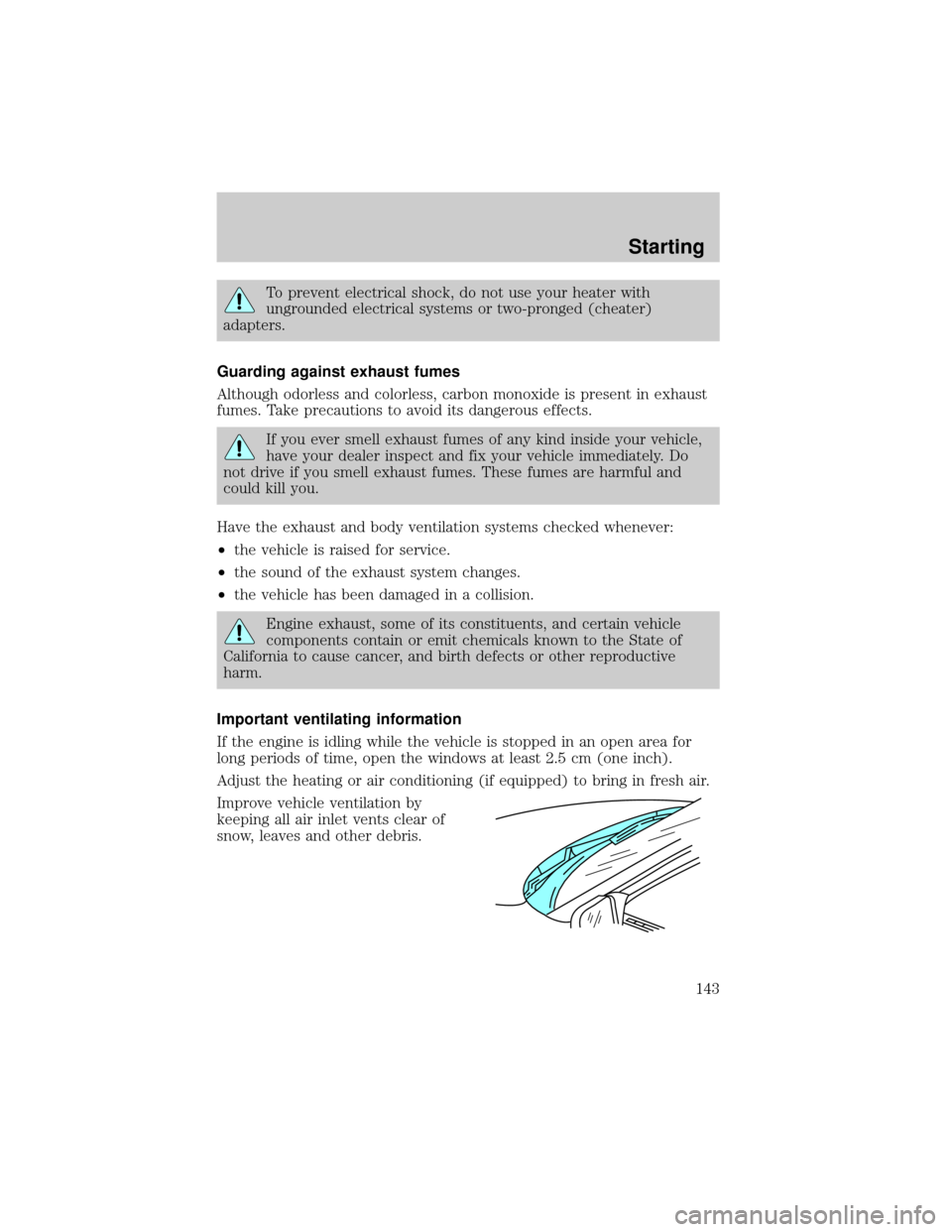heater Mercury Mountaineer 2000 Owner's Manuals
[x] Cancel search | Manufacturer: MERCURY, Model Year: 2000, Model line: Mountaineer, Model: Mercury Mountaineer 2000Pages: 264, PDF Size: 2.29 MB
Page 142 of 264

Make sure the corresponding lights illuminate briefly. If a light fails to
illuminate, have the vehicle serviced.
²If the driver's safety belt is fastened, the
light may not illuminate.
STARTING THE ENGINE
1. Turn the key to 5 (START)
without pressing the accelerator
pedal and release as soon as the
engine starts. The key will return to
4 (ON).
2. If the temperature is above ±12ÉC
(10ÉF) and the engine does not
start within five seconds on the first
try, turn the key to OFF, wait 10
seconds and try again.
3. If the temperature is below -12É C (10É F) and the engine does not
start in 15 seconds on the first try, turn the key OFF and wait 10
seconds and try again. If the engine does not start in two attempts, press
the accelerator pedal all the way to floor and hold. Turn the key to
START position.
4. When the engine starts, release the key, then release the accelerator
pedal gradually as the engine speeds up.
5. After idling for a few seconds, apply the brake and release the parking
brake.
Using the engine block heater (if equipped)
An engine block heater warms the engine coolant, which improves
starting, warms up the engine faster and allows the heater-defroster
system to respond quickly. Use of an engine block heater is strongly
recommended if you live in a region where temperatures reach -23ÉC
(-10ÉF) or below.
For best results, plug the heater in at least three hours before starting
the vehicle. Using the heater for longer than three hours will not harm
the engine, so the heater can be plugged in the night before starting the
vehicle.
3
2
1
5
4
Starting
142
Page 143 of 264

To prevent electrical shock, do not use your heater with
ungrounded electrical systems or two-pronged (cheater)
adapters.
Guarding against exhaust fumes
Although odorless and colorless, carbon monoxide is present in exhaust
fumes. Take precautions to avoid its dangerous effects.
If you ever smell exhaust fumes of any kind inside your vehicle,
have your dealer inspect and fix your vehicle immediately. Do
not drive if you smell exhaust fumes. These fumes are harmful and
could kill you.
Have the exhaust and body ventilation systems checked whenever:
²the vehicle is raised for service.
²the sound of the exhaust system changes.
²the vehicle has been damaged in a collision.
Engine exhaust, some of its constituents, and certain vehicle
components contain or emit chemicals known to the State of
California to cause cancer, and birth defects or other reproductive
harm.
Important ventilating information
If the engine is idling while the vehicle is stopped in an open area for
long periods of time, open the windows at least 2.5 cm (one inch).
Adjust the heating or air conditioning (if equipped) to bring in fresh air.
Improve vehicle ventilation by
keeping all air inlet vents clear of
snow, leaves and other debris.
Starting
143
Page 176 of 264

The fuses are coded as follows:
Fuse/Relay
LocationFuse Amp
RatingPassenger Compartment Fuse Panel
Description
1 7.5A Power Mirror Switch, Power Antenna,
Memory Seat
2 7.5A Blower Motor Relay, Air Bag Diagnostic
Monitor
3 7.5A Left Stop/Turn Trailer Tow Connector
4 10A Left Headlamp
5 10A Data Link Connector (DLC)
6 7.5A Rear Blower Motor (Without EATC)
7 7.5A Right Stop/Turn Trailer Tow Connector
8 10A Right Headlamp, Foglamp Relay
9 7.5A Brake Pedal Position Switch
10 7.5A Speed Control/Amplifier Assembly, Generic
Electronic Module (GEM), Shift Lock
Actuator, Blend Door Actuator, A/C -
Heater Assembly, Flasher, Overhead
Console, Load Leveling Module
11 7.5A Instrument Cluster
12 7.5A Washer Pump Relay, Rear Washer Pump
Relay
13 20A Brake Pedal Position Switch, Brake
Pressure Switch
14 10A 4 Wheel Anti-Lock Brake System (4WABS)
Module, 4WABS Main Relay
15 7.5A Instrument Cluster
16 30A Windshield Wiper Motor, Wiper Hi-Lo Relay,
Wiper Run/Park Relay
17 25A Cigar Lighter
18 25A Drivers Unlock Relay, All Unlock Relay, All
Lock Relay, Power Seats
19 25A PCM Power Diode
20 7.5A RAP Module, Generic Electronic Module
(GEM), Radio, Cellular Phone
Roadside emergencies
176
Page 186 of 264

Preparing your vehicle
1.Use only a 12±volt supply to start your vehicle.
2. Do not disconnect the battery of the disabled vehicle as this could
damage the vehicle's electrical system.
3. Park the booster vehicle close to the hood of the disabled vehicle
making sure the two vehiclesdo nottouch. Set the parking brake on
both vehicles and stay clear of the engine cooling fan and other moving
parts.
4. Check all battery terminals and remove any excessive corrosion before
you attach the battery cables. Ensure that vent caps are tight and level.
5. Turn the heater fan on in both vehicles to protect any electrical
surges. Turn all other accessories off.
Connecting the jumper cables
1. Connect the positive (+) booster cable to the positive (+) terminal of
the discharged battery.
Note:In the illustrations,lightning boltsare used to designate the
assisting (boosting) battery.
+–+–
Roadside emergencies
186
Page 254 of 264

Comfort and convenience
Cargo nets
Cargo organizers
Cargo shades
Engine block heaters
Home link visor
Tire step
Travel equipment
Auto headlamps with daytime running lamps (DRL)
Daytime running lights
Factory luggage rack adaptors
Fog lights
Heavy-duty battery
Interior mirror, electrochromic with compass (with and without
temperature display)
Removable luggage rack
Removable luggage rack adapters
Raised cross bars (for luggage rack rails)
Soft luggage cover
Trailer hitch (Class III)
Trailer hitch bars and balls
Trailer hitch mounted bike carrier
Trailer hitch wiring adaptor
Trailer hitch wiring harness
Protection and appearance equipment
Air bag anti-theft locks
Car/truck covers
Cargo liners, interior
Carpet floor mats
Cleaners, waxes and polishes
Customer assistance
254
Page 259 of 264

washing ....................................231
waxing .....................................232
wheels ......................................233
windows ..................................236
wiper blades ............................234
woodtone trim ........................236
Climate control (see Air
conditioning or Heating) ............22
Clock ..................................41,51,64
Compass, electronic ....................86
calibration .................................88
set zone adjustment .................87
Console ........................................97
overhead ...............................83,84
rear ............................................98
Controls
power seat ...............................113
steering column ........................82
Coolant
checking and adding ..............200
refill capacities .................204,237
specifications ...................240,242
Cruise control
(see Speed control) ....................77
Customer Assistance ................171
Ford accessories
for your vehicle ......................252
Ford Extended
Service Plan ............................245
Getting assistance outside
the U.S. and Canada ..............251
Getting roadside assistance ...171
Getting the
service you need ....................245
Ordering additional
owner's literature ...................256
The Dispute
Settlement Board ...................248
Utilizing the Mediation/
Arbitration Program ...............251
Daytime running lamps
(see Lamps) ................................21Defrost
rear window ..............................33
Dipstick
automatic
transmission fluid ...................206
engine oil .................................195
Doors
door ajar warning .....................12
lubricant specifications ..........240
Driveline universal joint
and slip yoke .............................209
Driving under special
conditions ...........................158,161
mud .....................157,158,160,161
sand ..................................158,160
snow and ice ......157,159,160,162
through water ...........158,161,165
Emergencies, roadside
jump-starting ..........................185
Emission control system ..........224
Engine ........................................242
check engine/service engine
soon light ....................................8
cleaning ...................................232
coolant .....................................200
idle speed control ...................210
lubrication
specifications ...................240,242
refill capacities ........................237
service points ...................194,195
starting after a collision .........172
Engine block heater .................142
Engine oil ..................................195
checking and adding ..............195
dipstick ....................................195
filter, specifications .........198,237
recommendations ...................198
refill capacities ........................237
specifications ...................240,242
Exhaust fumes ..........................143
Floor mats ...................................99
Fluid capacities .........................237
Index
259